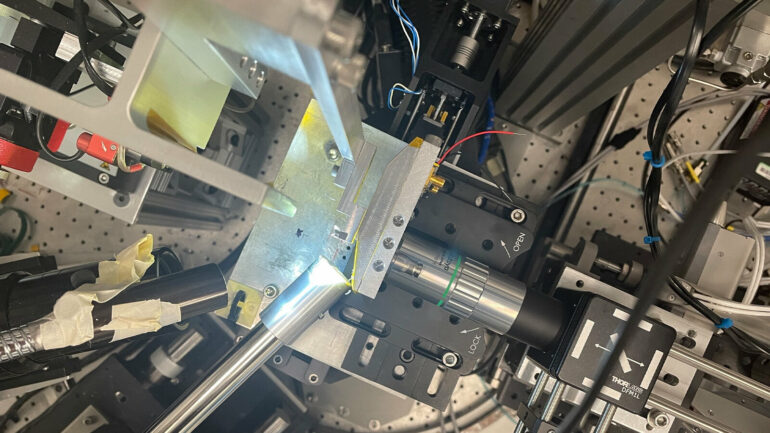Using the bright X-rays of the Advanced Photon Source and a custom-built characterization platform, scientists have traced the ion movements inside perovskites, a potential material for new solar energy harvesting devices.
Solar farms are gaining an increasing foothold in combating climate change, and scientists are on the hunt for new materials to make solar panels even more efficient. Increasing that efficiency means studying light-detecting and light-emitting materials, which form the basis of the study of optoelectronics. One class of these new materials is called perovskites.
Researchers using the Advanced Photon Source (APS), a U.S. Department of Energy (DOE) Office of Science user facility at DOE’s Argonne National Laboratory, recently published a study in Joule revealing the way ions move within different perovskite crystals under ultraviolet radiation (UV). Scientists are interested in testing material stability under UV because it can significantly degrade solar cell performance, sometimes by more than 50%, after extended exposure.
Electricity is harvested from light when it collides with a solar cell, knocking electrons out of their bonds and allowing them to circulate and move around. However, instability in perovskites means that iodine, for example, leaves the system as iodine gas, creating a vacancy for ions to migrate towards, causing defects that make the system cease functioning. Researchers hope to improve perovskite stability to achieve a solar cell lifetime of twenty to thirty years, making them more useful to industry.
“Perovskite has a lot of potential for solar cells, and also for use in LED displays. At Argonne, we hope to use the powerful X-ray beams to decode perovskites’ mysteries and uncover potential pathways to conquer their stability hurdles,” said Argonne materials scientist Yanqi (Grace) Luo, the lead author on the paper.
Perovskites’ potential use in solar cells is high on the list for the next solar energy breakthrough in climate resilience. Commercial multicrystalline silicon solar cells can convert 10–15% of the sun’s energy to electricity. But perovskites, since initial experiments in 2009, have increased that to as much as 26%, outperforming many other types of solar cells.
To enhance perovskite solar energy conversion, scientists improve material stability through innovative compositions and structural engineering. By altering halide ratios and adding these ions in varying sizes or amounts, scientists can change favorably perovskites’ nature and use.
Since the light-harvesting characteristics of these hybrid perovskites are unstable and easily altered, extra care and a specially designed scientific setup were required to study them. Some microscopes can record only a snapshot, providing a certain set of information about a sample at the instant of measurement. Instruments at the APS can record and provide data on conditions of the sample during the entire observation, meaning researchers studying nanoscience can witness changes as they occur.
Luo’s team has shown that by using a sophisticated technique called nanoprobe X-ray fluorescence (nano-XRF), they can directly capture the movement of halide atoms in perovskite materials before damaging them.
“This is a new platform to see precisely, at the nanoscale, what happens when the experimental materials are in operation,” said Argonne physicist Luxi Li, another author of the study.

The periodic table of elements, organized by number of proteins, group and by column. Row 17 (circled) shows the halides used in Luo’s experiment. © Argonne National Laboratory
The perovskite samples used by the team were lab-created low-dimensional or 2D materials. They consist of thin sheet of perovskites that are neatly sandwiched between two layers of bulky organic molecules. The researchers first performed nano-XRF measurements on the 2D crystals by collecting high-resolution elemental maps of atoms inside the materials.
Then the researchers shined the same nano-focused X-ray probe to measure the atomic structure via X-ray absorption spectroscopy (XAS). The nano-XRF and XAS captured the halide redistribution and structural reduction in these 2D crystals under continuous UV irradiation, respectively. These findings provide new insights into understanding the degradation mechanisms in these material systems.
With the newly constructed XRF platform, the researchers added a few specialized optics and sensors that allowed them to carefully adjust the brightness of light and detect X-ray-excited optical photons during scans. The results indicated that lower dimensional perovskites show a clear link between stability and dimensionality. Substituting certain elements of the material and protecting the material with sheets of organic molecules provide a potential route to increase the stability of perovskite-based photovoltaics.
So, what’s next for perovskites? The MIT Technology Review selected perovskite solar as one of its top 10 breakthrough technologies for 2024. Currently, Luo and her team are exploring other approaches to limit the degree of halide redistribution to enhance material stability. And when the APS upgrade is complete, researchers like Luo and Li will be ready to pummel perovskites with yet more powerful X-rays.
“With the APS upgrade coming up, it should allow us to better understand the behavior and working principles in energy materials on various time scales,” Luo said.
The upgraded APS is expected to be online by spring 2024, at which time the APS will feature X-ray beams that are up to 500 times brighter. With Luo’s characterization platform, the team will get a brighter and better picture of how to continue advancing perovskite potential.
More information:
Yanqi Luo et al, Photo-induced halide redistribution in 2D halide perovskite lateral heterostructures, Joule (2023). DOI: 10.1016/j.joule.2023.08.003
Provided by
Argonne National Laboratory
Citation:
X-rays light the way to more stable solar cell materials (2024, January 23)



